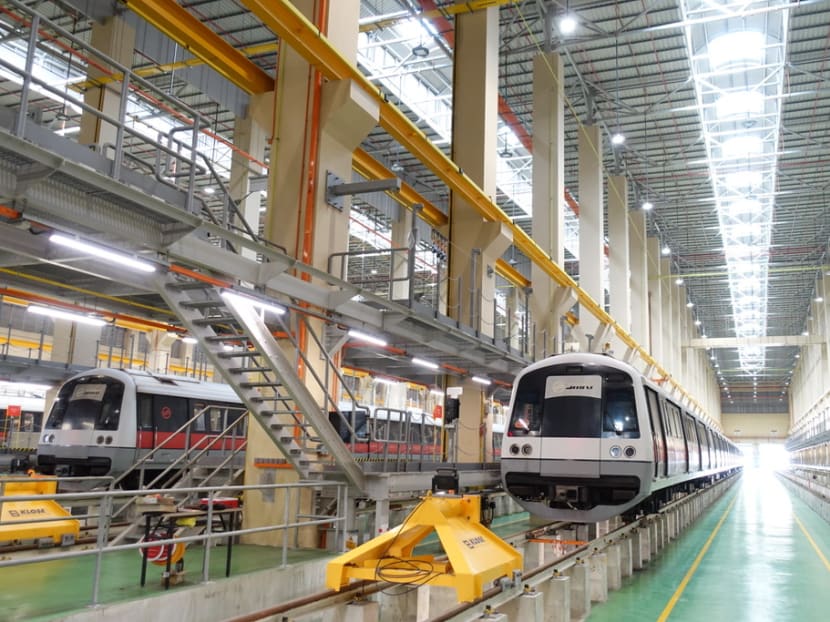Tuas Depot would take pressure off existing depot, boost power capacity: Khaw
SINGAPORE — The recently completed Tuas Depot, which has a new substation and provides the East-West Line with its own major maintenance facility, will allow the rail network’s staff to “sleep a little bit better”, Transport Minister Khaw Boon Wan said on Monday (Nov 13).

A new substation at Tuas Depot will help boost power capacity along the North-South, East-West lines by about 50 per cent. Photo: Koh Mui Fong/TODAY
SINGAPORE — The recently completed Tuas Depot, which has a new substation and provides the East-West Line with its own major maintenance facility, will allow the rail network’s staff to “sleep a little bit better”, Transport Minister Khaw Boon Wan said on Monday (Nov 13).
“For 30 years, we have only the Bishan Depot to support two major MRT lines (the North-South and East-West Lines), for all their major maintenance overhaul activities. This is a severe handicap for our engineering and maintenance crew,” Mr Khaw told a showcase of future railway technologies for depots and trains.
“In a way, Tuas Depot is 30 years’ late, but better late than never!”
The new substation at Tuas Depot will help boost power capacity along the North-South, East-West lines by about 50 per cent.
Currently, the two lines draw power from four substations across the island, at Buona Vista, Bishan, Stamford and Yasin.
Mr Khaw said that at peak hour, the power load is around 80 per cent, and was expected to go up by another 25 per cent, with the opening of the Tuas West Extension on the East-West Line, and the completion of resignalling works.
This requires the authorities to tap into back-up power reserves, and “that was how close we cut it,” Mr Khaw noted, adding: “(And) the need to reduce crowdedness in trains ... forced us to add new trains, further pushing the limits on our power capacity.”
He also pointed out that the existing substations have aged “significantly” and would need to be renewed soon.
In his speech, Mr Khaw, who is also Co-ordinating Minister for Infrastructure, sought to put the “stark” differences between Republic’s older and newer MRT lines in perspective.
For instance, the first phase of the North-South line cost S$4.41 billion to build, compared with the S$21 billion it took to build the Downtown Line, Singapore’s newest line. This meant that the cost per kilometre had tripled from around S$160 million to S$490 million.
Mr Khaw noted that the North-South Line had, until recently, operated an analogue communication system, known as the Fixed Block Communication System.
The Downtown Line operates on a Communications-Based Train Control system which, as a digital system, allows remote control of most train functions, thus boosting the line’s reliability, he added.
The minister added that the North-South line had fewer stations, with 40 per cent of it underground, while the Downtown Line was completely underground with a higher proportion of stations that are interchange stations.
Said Mr Khaw: “Technology advancement partly explains the differences. But there is a major factor underpinning the stark differences.
“Thirty years ago, Singapore’s per capita GDP was S$16,398, last year in 2016, it has grown more than four times to S$73,167.
“It was a very different era. Finance was tight, it still is, so we really had to scrutinise every dollar of spending, especially big ticket items like an MRT line.”
Budgetary constraints faced by the government decades ago, along with land constraints, were flagged by Mr Khaw in Parliament last week, as he fielded questions from Members of Parliament afer delivering a ministerial statement on the Oct 7 tunnel flooding which halted services on the North-South Line.
Mr Khaw said that the design of the North-South, East-West lines were “not ideal”, and that overcoming these issues could require a reduction of operating hours - a point he reiterated on Monday.
“Power supply is one of the six key ageing assets of the North-South and East-West Lines which we need to renew,” the minister added.
“That is why we need more engineering hours. This can only come if we reduce train operating hours. It is a zero-sum game.”






